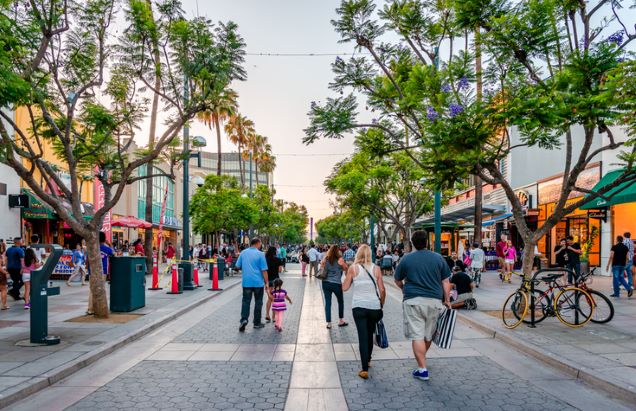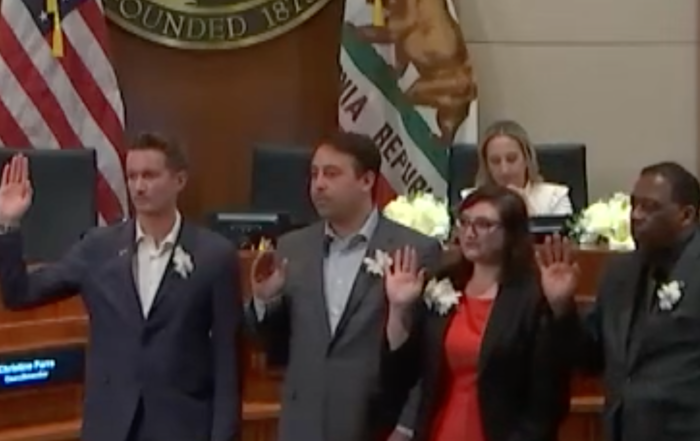Santa Monica’s City Council held a study session on Tuesday regarding the state of public safety in the city alongside efforts to combat homelessness.
City entities focused on public safety in the city — the Police Department, Fire Department, Department of Housing and Human Services, Office of Emergency Management, and City Attorney’s Office — each briefly presented the state of their department while providing proposals regarding programs and staffing for the council to consider.
Here are several highlights:
Police Allocation is at an All-time High Despite Funding Issues.
The Santa Monica Police Department (SMPD) has 232 officer positions allocated to it in the Santa Monica Budget, with 214 of those positions filled. SMPD Police Chief Ramon Batista said it was the most officers ever earmarked for the department in its more than 125-year history.
On the other hand, departments like the City Attorney’s Office and Office of Emergency Management are still feeling the effects of cutbacks made during the COVID-19 pandemic. This has resulted in the shifting of responsibilities in an unproductive way, including lawyers with the City Attorney’s Office being tasked with administrative work.
“Administering grants…is taking lawyer’s time,” City Attorney Douglas Sloan said, “Time that could be spent reviewing filings and going to court.”
Each of the other departments at the meeting reported position losses since the pandemic, with several departments requesting additional staffing to compensate for these continued deficits. The City Attorney’s Office has lost about 10 percent of its staff — a total of five positions — since the COVID-19 pandemic, two of which were in criminal prosecution.
Sloan’s office requested “at minimum an additional Administrative Position, but ideally two,” and another lawyer to keep up with the 70 percent increase in cases referred to the city attorney’s office by Santa Monica Police.
“Our goal is to prosecute every case in which we believe we can get a jury to find a guilty verdict,” Sloan said.
The Office of Emergency Management (OEM) — whose Public Safety Communications Division handles 911 and non-emergency telephone calls and dispatches public safety resources — lost 25 percent of staff in its communications center due to high turnover and a competitive market from 2020 to 2023, resulting in an average of 446 hours of overtime for dispatchers over the last fiscal year according to Chief Resilience Officer and Emergency Operations Director Lindsay Call.
“That’s adding almost a month of mandated work on top of every employee,” Call said. “High overtime leads to morale challenges and high turnover.”
OEM requested an additional full-time lead dispatcher to help alleviate these staffing concerns incrementally. This would help replace a position lost in dispatch during COVID and also aligns with a study from consulting firm Moss Adams that suggests the department add three dispatcher positions, including this lead dispatcher position to help handle the more than 216,000 calls that the department handled in the past fiscal year.
Advanced Provider Unit would Expand on the Community Response Pilot
One proposal that received universal praise was the Advanced Provider Unit (APU) brought forward by the Fire Department. There would be two teams — each comprising one firefighter and one nurse practitioner that expands on the Community Response Unit Pilot Program.
These teams would operate around the clock, and could enforce mental health holds, treat or transfer patients, respond to house calls, order prescriptions, and provide more in-depth out-of-hospital care or intervention allowed by a lack of regulation by Los Angeles County’s Local EMS Agency (LEMSA)
The current support teams like Wise and Healthy Aging and the Therapeutic Transport Team that currently operate do not do so 24/7, so the Fire Department must respond without these teams to overnight and weekend calls. Fire Chief Matt Hallock said that the department already has two ambulances that could be used by the program without incurring additional costs, and has already proven successful in both Los Angeles and Beverly Hills.
“Both of these programs have been extremely successful within these agencies,” Hallock said of L.A. and Beverly Hills’ APU programs. “L.A. is currently expanding their APU implementation to a 24/7 capacity.
Vice Mayor Lana Negrete wondered why this program was necessary with the existence of the Community Response Team (CRT) — a pilot program that ran for two years and finished in July 2023.
Deputy Police Chief Darrick Jacob explained that the program would not be able to be converted into a permanent program for legal reasons, but that the APU was created using lessons learned from the success of the CRT. The APU would have more power than the CRT because of its disassociation with the LEMSA.
Support for the program was abundant, with Councilmembers Jessie Zwick and Gleam Davis expressing particular enthusiasm. Davis praised the focus on street crisis response and mobile urgent care as effective tools to combat homelessness issues. She also emphasized the importance of following up with people after they have been cared for to build that relationship.
“I find the APU idea incredibly exciting,” Davis said.
Downtown Outreach Team Could Enforce Doorway Laws
The Department of Housing and Human Services focused on issues with visibility and outreach in the Downtown area. In particular, the abundance of calls related to violations of a city ordinance that prohibits sitting or lying in doorways of local businesses has caused concern in the department.
There were 157 calls for trespassing in the area in the month of July alone, with 86 of those related to unhoused residents. A Downtown Outreach Team consisting of a code enforcement officer and an outreach worker would help respond to these calls and enforce the no sit/no lie ordinance while improving visibility and feelings of safety in Downtown Santa Monica.
“[It is] a tangible way to make tourists, employees, and community members feel safe,” said Director of Housing and Human Services Heather Averick.
These teams would mainly operate in the early morning to clear people from the Promenade and alleviate calls for service related to these individuals, according to Averick.
Vice Mayor Negrete questioned the need to involve code enforcement with the unhoused. She also mentioned that some code enforcement officers did not want to interact with people without protection due to physical threats, prompting her to believe that the fit was not right.
“Code enforcement doesn’t seem like the appropriate personnel to deal with the homeless population and connect them to services,” Negrete said. “They haven’t had that level of training, and I think it would put them in a precarious position.”
Averick argued that code enforcement’s ability to write citations to officially enforce the city’s laws, contributing to the overall mission to assist police by minimizing low-level calls like trespassing.
“I think the benefit is that this is where we get people into [the Shelter, Treatment, and Empowerment Program] and our diversion programs,” Averick said. “The goal is to get them on a pathway so that they aren’t re-offenders in the future.”
Special Investigation Unit Proposal Hones in on Narcotics Trade
One of the top priorities for police to discuss at the meeting was their proposed implementation of a Special Investigation Unit meant to address the issue of the narcotics trade permeating Santa Monica.
Narcotic deaths have decreased in recent years due to several factors — particularly the introduction of overdose-reversing Naloxone use. Police Chief Ramon Batista said that the SMPD has saved 122 lives since the department began using the medicine in January 2019.
However, Batista explained that the narcotics trade in the city has created addicts who continue to be responsible for a disproportionate amount of petty financial crimes including shoplifting, vehicle break-ins, and burglaries.
This new Special Investigation Unit would consist of one Sergeant and one Officer who would specifically be tasked with “more deeply investigating the issue of the narcotics trade” in Santa Monica.
“A narcotics unit would help stem the flow of drugs coming into our city,” Batista said.
Batista recalled an incident “three or four months ago” when almost a pound of fentanyl was found during a traffic stop in Downtown Santa Monica. He says that it is suspected that narcotics can get into the city through several methods, including via motorcycle and bicycle.
Zwick said he supported the proposal and the department proactively attacking the narcotics issue. He asked about whether or not the officers for the unit could be pulled from the 214 that the department currently has.
Batista said that staff has been stretched as much as it can be despite the high staffing allocation, explaining that several different units do not have sergeants overseeing them, and promoting from within would qualify as an overhire.
“I don’t want to get to a point that we are operating with officers acting in the role of sergeant,” Batista said. “That is the only next choice that we have.”
Photo by Apostolos Giontzis on iStockphoto.com
Stay informed. Sign up for The Westside Voice Newsletter
By clicking submit, you agree to share your email address with Westside Voice. We do not sell or share your information with anyone.








